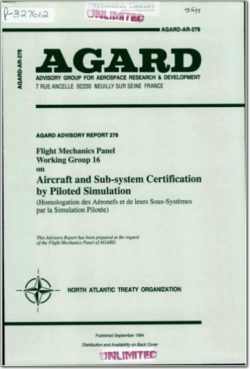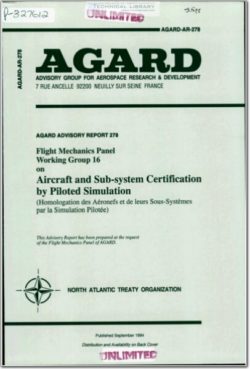AGARD-AR-278

- Version
- 222 Downloads
- 10.82 MB File Size
- 1 File Count
- April 25, 2016 Create Date
- April 25, 2016 Last Updated
Aircraft and Sub-System Certification by Piloted Simulation

Piloted flight simulators are a powerful tool for
designers to study the influence of the pilot in the
dynamic behaviour of new aircraft, new systems and
new operating environments. They also provide training
for pilots in managing the complex cockpit environment
and the wide range of emergency conditions which
might arise from failures or adverse operational condi-
tions. For many years simulators have been used
successfully to predict and assess solutions to problems
arising during the development of new aircraft and
systems. However, until recently, with the exception of
very specialised aircraft such as the US Space Shuttle,
all aircraft acceptance/certification has required flight
test demonstration.
This situation is changing as the complexity of safety
critical systems increases and presents the acceptance
authority with a very large set of potential failure
modes. Also, improvements in the standards of flight
simulation are increasing confidence in their ability to
represent many flight situations well enough to limit the
range of conditions that require flight testing. By
holding flight clearance testing within reasonable
bounds there are significant savings in cost and time,
which are eagerly embraced by both manufacturer and
customer. There are now examples where piloted simu-
lation has been used to 'demonstrate' to acceptance
authorities a range of failure modes of, for example, a
multi-channel 'fly-by-wire' flight control system. From
these demonstrations, the authorities, quite reasonably,
selected for flight demonstration those situations that
appeared to be most demanding and most probable.
Economic and practical time limitations are going to
increase the range of situations where piloted simulation
will be used as a direct part of the acceptance and certi-
fication processes for military and civil aircraft and their
systems.
This increasing use of piloted simulation for acceptance
testing of aircraft is a natural consequence of the
increasing physical understanding of aircraft and their
operational environment, and confidence in the 'validity'
of piloted simulation. Confidence in validity is the
criterion that must be applied. How is such confidence
derived?
| File | Action |
|---|---|
| AGARD-AR-278 Aircraft and Sub-System Certification by Piloted Simulation.pdf | Download |

Comment On This Post